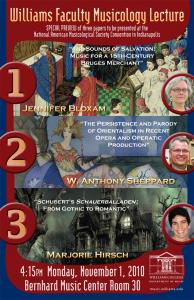
Department Musicology Lecture
Mon, November 1st, 2010
4:15 pm
- This event has passed.

The Williams College Department of Music presents a trio of lectures by our own faculty members on Monday, Nov. 1, at 4:15p p.m. in Bernhard Music Center Room 30. This free event is open to the public.
Williams College Music Department faculty members Jennifer Bloxam, W. Anthony Sheppard, and Marjorie Hirsch have all been selected to present papers at the National American Musicological Society Convention in Indianapolis. They will present a preview of each of their talks beforehand.
Jennifer Bloxam
Jennifer Bloxam will discuss the prize-winning digital media project The Sounds of Salvation: Music for a 15th-Century Bruges Merchant that she recently completed in collaboration with the Dutch early music ensemble Cappella Pratensis. This project encompasses a DVD+CD, a website, and scholarly articles, all centered on re-creating the Mass for St. Donatian, a memorial Mass with polyphony by the great Flemish composer Jacob Obrecht. The aims and challenges of the project will be explored, and various segments of the project demonstrated.
Marjorie Hirsch
Schubert’s Schauerballaden: From Gothic to Romantic
As a youth, Franz Schubert was gripped by the Gothic. This is clear from the many Schauerballaden—songs relating gruesome tales of horror—he composed during the early to mid 1810s. With a few exceptions, these songs are widely regarded as an embarrassing if forgivable product of youthful enthusiasm for the macabre that fortunately gave way to a more mature artistic vision in his later years. The critical tendency to slight most of these early Schauerballaden has had unfortunate consequences. Not only has it led to overly hasty judgments of individual settings, it has obscured Schubert’s important role in the absorption and transformation of 18th-century Gothicism into 19th-century Romanticism. Far from a youthful dalliance, poetic tales of horror continued to lure Schubert throughout his career, and comparison of early and later settings reveals a crucial evolution of tone and technique.
This paper scrutinizes Schubert’s treatment of the horror topos in five songs composed between 1815 and 1828: “Die Nonne,” “Erlkönig,” “Der Zwerg,” “Der Doppelgänger,” and “Eine altschottische Ballade.” As the paper will show, the evolution in Schubert’s handling of horror stems largely from his growing attraction to 19th-century verse. In Schubert’s settings, horror escalates as its causes become increasingly psychological, ill-defined, incomprehensible, and unbounded. This intensification of effect finds musical expression in heightened motivic unity and structural coherence, changes that suggest a merger of the dramatic ballad and the “Romantic” Lied.
W. Anthony Sheppard
“The Persistence and Parody of Orientalism in Recent Opera and Operatic Production”
Over the past two decades, Orientalist representation has emerged as a major topic in operatic scholarship. Recently, scholars have attempted to define the parameters of musical Orientalism more precisely and to offer a periodization of its history. These studies tend to assume that the techniques and motivations of Orientalism belong primarily to opera’s past. When faced with elements of operatic exoticism in their analyses of recent operas, scholars have repeatedly argued that parody is in play or that the signifiers of exoticism are no longer potent. Numerous composers and directors likewise have declared their separation from the Orientalist past in reference to their exotic representations. Has “postmodern” and “post-colonial” opera and operatic production achieved an emancipation of Orientalist signs?
To test these claims I have investigated numerous operas and music theater works from the past three decades by a variety of composers, including Glass, Corigliano, Adams, Weir, Sheng, Tan Dun, and Rihm, as well as recent productions of canonical Orientalist operas. In this paper I will make brief reference to multiple contemporary operas and recent productions, but will focus in comparative fashion on works by John Adams and John Corigliano.